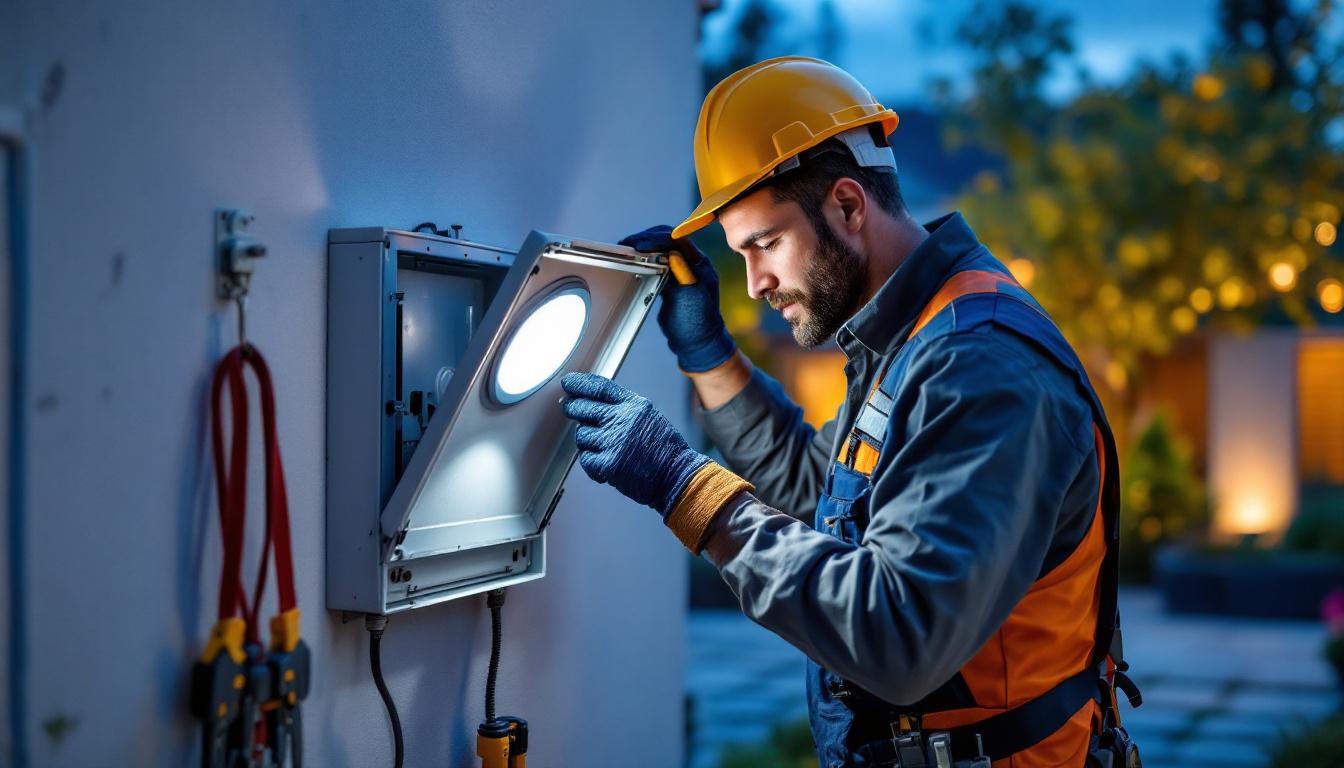
As outdoor lighting projects become increasingly popular, the implementation of motion sensor lighting systems has gained significant traction. These systems not only enhance security and convenience but also contribute to energy efficiency. However, like any installation, there are pitfalls that can lead to costly mistakes. This article will explore common errors in motion sensor lighting projects and provide valuable insights to help lighting contractors avoid them.
Before diving into the specifics of installation, it is essential to grasp the fundamentals of motion sensor technology. Motion sensors detect movement within a designated area and trigger lighting accordingly. This technology can be categorized into three primary types: passive infrared (PIR), microwave, and dual technology sensors.
PIR sensors are the most common, utilizing infrared radiation to detect body heat. Microwave sensors emit microwave pulses and measure the reflection off moving objects. Dual technology sensors combine both methods, offering increased reliability and reduced false alarms. Understanding these technologies will aid contractors in selecting the right sensor for specific applications.
Not all motion sensors are created equal, and selecting the appropriate type for the environment is critical. For instance, PIR sensors are ideal for residential areas where human movement is expected, while microwave sensors may be more suitable for commercial applications where larger areas need coverage.
Contractors should also consider the installation environment. For example, outdoor sensors need to withstand varying weather conditions, so selecting models with appropriate weatherproof ratings is essential. Additionally, understanding the coverage area and range of each sensor type will ensure optimal performance.
Another important factor to consider is the sensitivity settings of the sensors. Many modern motion sensors come with adjustable sensitivity levels, allowing users to fine-tune the detection range to minimize false triggers from pets or passing vehicles. This feature is particularly beneficial in residential settings, where unwanted activations can lead to annoyance and unnecessary energy consumption. Furthermore, some sensors include a delay feature, which allows lights to remain on for a set period after motion is no longer detected, enhancing convenience without wasting energy.
Moreover, the integration of smart technology into motion sensors is revolutionizing how we interact with our environments. Many contemporary sensors can connect to home automation systems, enabling remote monitoring and control through smartphones or tablets. This capability not only increases security by allowing homeowners to receive alerts when motion is detected but also provides opportunities for energy savings by optimizing lighting schedules based on actual usage patterns. As technology continues to evolve, the potential applications for motion sensors are expanding, making them an increasingly valuable addition to both residential and commercial spaces.
Even experienced contractors can make mistakes during the planning and installation phases of motion sensor lighting projects. Recognizing these common errors can save time and resources, ensuring a smoother installation process and satisfied clients.
A thorough site assessment is crucial before any installation. Failing to evaluate the area where the sensors will be placed can lead to miscalculations in sensor placement, resulting in ineffective coverage. Factors such as landscaping, building structures, and potential obstructions should be carefully considered.
Contractors should also take into account the typical movement patterns in the area. For instance, if the lighting is intended for a driveway, understanding the flow of traffic—both pedestrian and vehicular—will help determine the optimal sensor placement. A well-conducted site assessment can prevent costly rework and ensure that the lighting system meets the client’s needs. Additionally, seasonal changes in foliage or landscaping can affect sensor performance; therefore, it’s wise to consider how these elements may evolve over time. For example, trees may grow and block sensor views, or new landscaping may create unexpected shadows that could interfere with detection.
Even with the right sensors, improper placement can lead to ineffective lighting. Sensors should be installed at a height that maximizes their detection capabilities, typically between 6 to 10 feet off the ground. Additionally, placing sensors too close to walls or obstructions can hinder their ability to detect motion accurately.
Contractors should also consider the angle of detection. Most motion sensors have a specific field of view, and positioning them at the right angle is essential for optimal performance. A common mistake is to install sensors facing away from the expected direction of movement, which can lead to missed detections and frustration for the client. Furthermore, it’s important to account for environmental factors such as wind and rain, which can create false triggers if sensors are not positioned correctly. Testing the sensors after installation is a critical step that many overlook; running a few motion tests can help ensure that the sensors are functioning as intended and provide valuable feedback for any necessary adjustments.
Power supply is a fundamental aspect of any lighting project, and motion sensor lighting is no exception. Understanding the power requirements for the chosen sensors and ensuring a reliable power source is essential to avoid future complications.
Each motion sensor comes with specific power requirements, which can vary significantly depending on the technology used. Contractors should review the specifications carefully and ensure that the power supply can handle the load. Inadequate power supply can lead to flickering lights, malfunctioning sensors, or complete system failure.
Additionally, considering the type of power source is crucial. While many outdoor motion sensors are hardwired, some options are battery-operated or solar-powered. Each type has its advantages and disadvantages, and contractors should evaluate the best fit for the project based on the client’s needs and the installation environment.
Proper wiring is vital for the functionality of motion sensor lighting systems. Contractors should ensure that the wiring is compatible with the sensor’s specifications and that it meets local electrical codes. Using the wrong gauge wire or failing to account for voltage drop can lead to performance issues.
Furthermore, it is essential to consider the circuit load. Overloading a circuit can lead to tripped breakers and potential safety hazards. Contractors should calculate the total wattage of all connected devices and ensure that the circuit can handle the load without exceeding its capacity.
Once the sensors are installed, programming them correctly is crucial for optimal performance. Many motion sensors come with adjustable settings that allow contractors to customize the sensitivity, duration of light activation, and other features.
One of the most common mistakes is failing to adjust the sensitivity level of the sensors. If set too high, the sensors may trigger unnecessarily due to small animals or environmental factors such as wind. Conversely, if set too low, they may not detect legitimate movement, leading to frustration for the client.
Contractors should test the sensors after installation and make necessary adjustments based on the specific environment. This may involve walking through the detection zone to ensure that the sensors respond appropriately to human movement while ignoring irrelevant triggers.
Another important aspect of programming is the activation duration, which determines how long the lights remain on after detecting motion. Setting this duration too short may lead to lights turning off before a person can safely navigate the area, while setting it too long can waste energy.
Contractors should discuss the ideal activation duration with the client, considering factors such as the typical movement patterns and the specific use of the area. Finding the right balance will enhance user experience and contribute to energy efficiency.
Even after a successful installation, ongoing maintenance is essential to ensure the longevity and effectiveness of motion sensor lighting systems. Neglecting maintenance can lead to performance issues and dissatisfied clients.
Contractors should recommend regular inspections to clients, focusing on the sensors, wiring, and lighting fixtures. Over time, dirt and debris can accumulate on sensors, obstructing their ability to detect motion accurately. Regular cleaning and inspections can prevent these issues and maintain optimal performance.
Additionally, checking for any signs of wear or damage to the wiring and fixtures is crucial. Addressing minor issues promptly can prevent more significant problems down the line, saving both time and money for the client.
As technology evolves, so do the capabilities of motion sensor lighting systems. Contractors should stay informed about advancements in sensor technology and consider recommending upgrades to clients when appropriate. Newer models may offer enhanced features, improved energy efficiency, and better performance.
Encouraging clients to invest in updated technology can lead to increased satisfaction and potentially open up new business opportunities for contractors. Staying ahead of the curve in technology will not only benefit clients but also enhance the contractor’s reputation in the industry.
Motion sensor lighting systems offer numerous benefits, from enhanced security to energy efficiency. However, avoiding common mistakes during the planning, installation, and maintenance phases is crucial for successful projects. By understanding the technology, conducting thorough site assessments, ensuring proper placement and wiring, and providing ongoing maintenance, contractors can deliver exceptional results for their clients.
Ultimately, a well-executed motion sensor lighting project can lead to satisfied clients, repeat business, and a strong reputation in the lighting industry. By following the guidelines outlined in this article, contractors can navigate the complexities of motion sensor lighting with confidence and avoid costly missteps along the way.
Ready to elevate your outdoor lighting projects with the best motion sensor technology? Look no further than LumenWholesale, where we provide contractors with the highest quality, spec-grade lighting products at unbeatable wholesale prices. Say goodbye to local distributor markups and hello to superior lighting products that meet the highest industry standards. With LumenWholesale, you can enjoy the convenience of bulk buying with free shipping, ensuring that you get premium lighting at the best value — without hidden fees or compromises. Make your next lighting project a success and experience the perfect blend of quality, affordability, and convenience with LumenWholesale.

Discover the essential checklist for lighting contractors to ensure flawless can lighting installations.

Discover the essentials of solar-powered indoor lighting in just five minutes.

Discover how True Lumens can help lighting contractors win more bids by providing accurate, reliable lighting measurements. Boost your success rate today!.

Discover innovative hacks for smart lighting contractors to effectively cover outdoor electrical boxes.